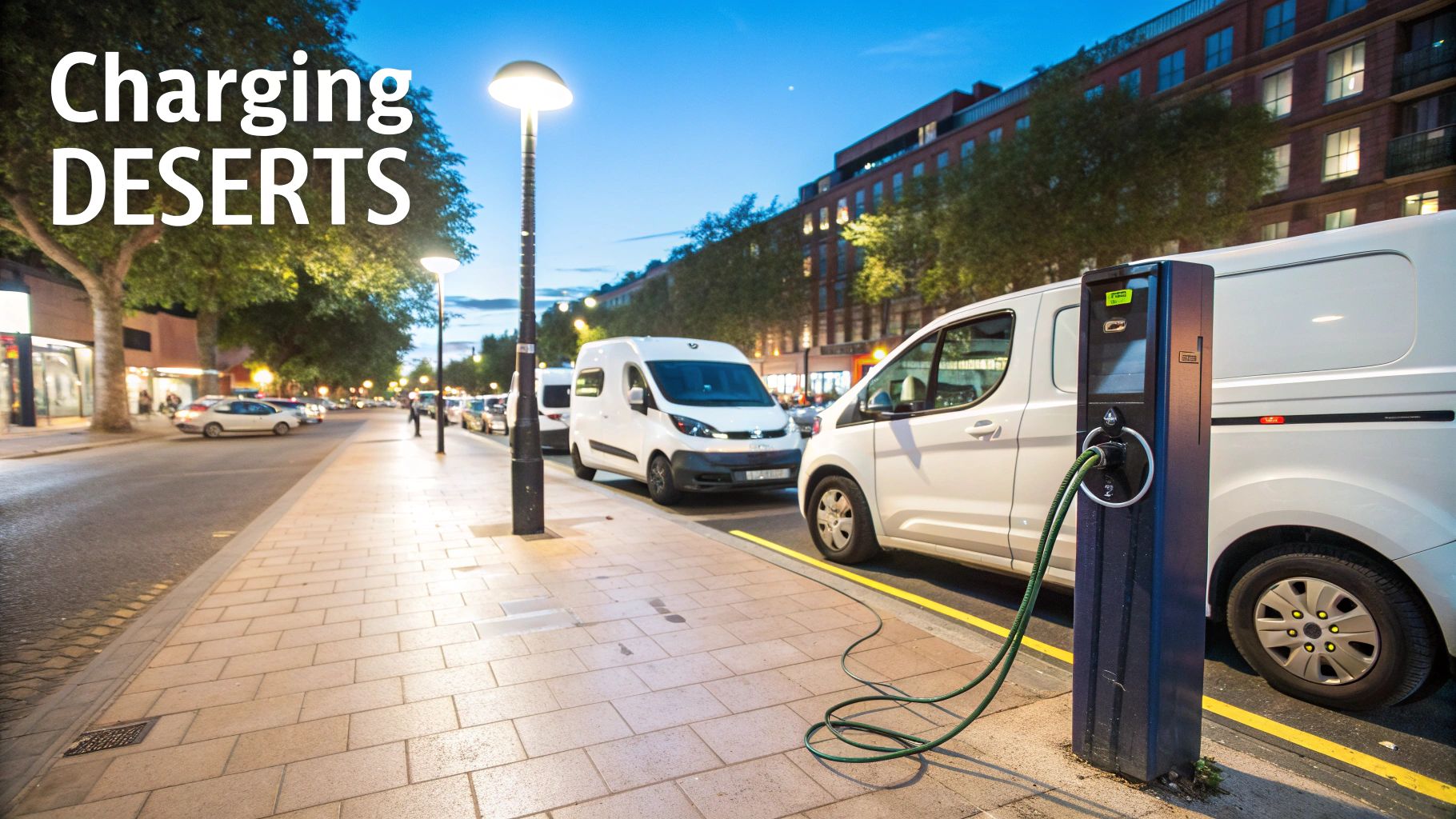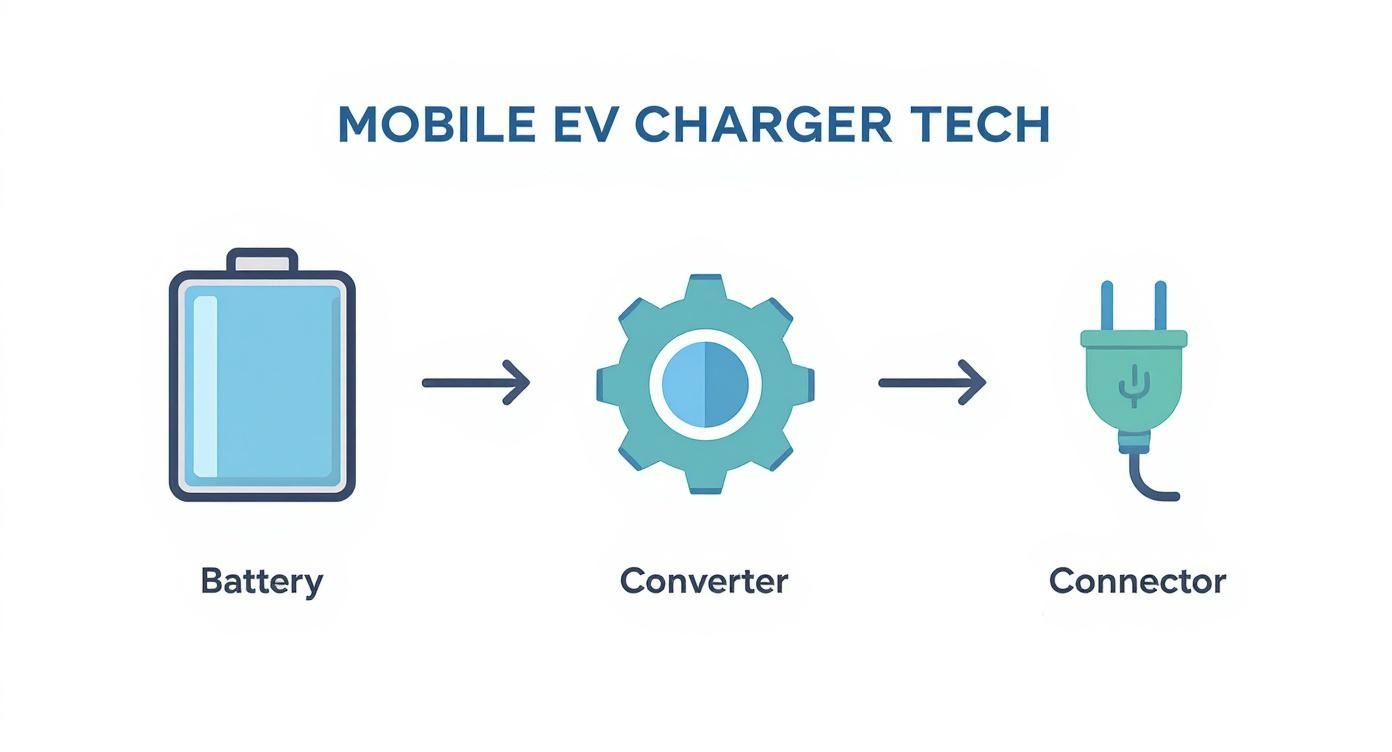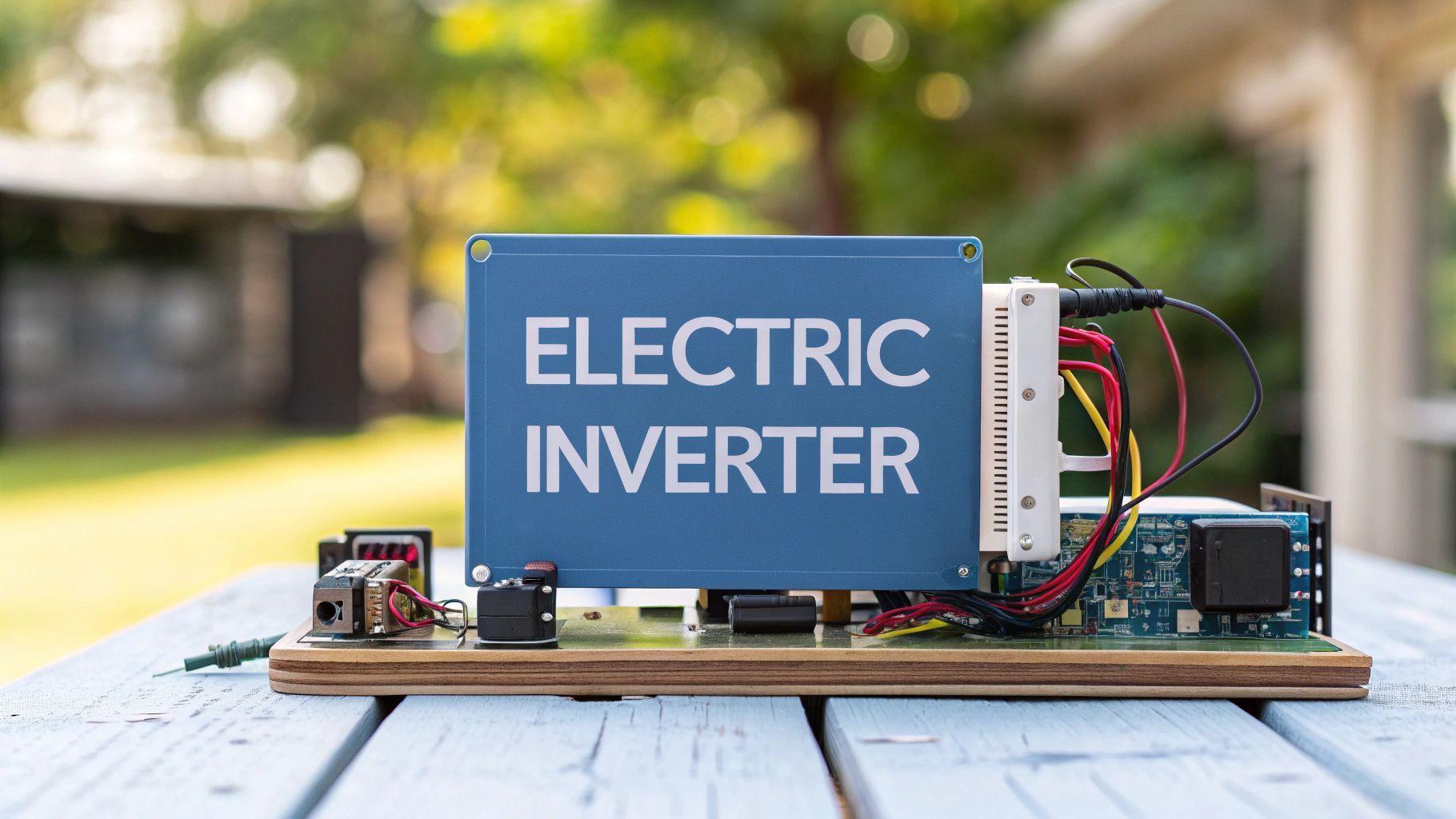Mobile EV Chargers The Ultimate Flexible Charging Solution
Think of a mobile EV charger as a powerful, commercial-grade power bank on wheels. These are self-contained, battery-powered units that can deliver rapid charging to electric vehicles pretty much anywhere, completely sidestepping the need for a direct, high-power connection to the grid. They are the perfect answer when fixed charging infrastructure is either impossible or just does not make sense.
The Challenge of Powering the EV Revolution

The UK’s shift to electric vehicles is picking up real pace but our national energy grid is creaking under the strain. For every electric car, van and lorry that hits the road, the demand for accessible, powerful charging points skyrockets. This surge is creating some serious headaches for businesses and organisations all over the country.
In busy city centres, the local grid is often maxed out already. If a fleet manager wants to install a bank of rapid chargers at their depot, they are often looking at a painfully slow and eye-wateringly expensive process. It frequently involves major grid upgrades that can take months, sometimes even years, to get sorted. This is the harsh reality of trying to install EV charging from constrained grid connections.
Overcoming Geographic and Infrastructural Hurdles
It's not just a city problem either. Many rural and remote areas have become ‘charging deserts’, where the local grid simply does not have the muscle to support the rapid EV charging that modern vehicles demand. This leaves businesses and entire communities stuck, unable to fully join the electric transition.
This is where the limits of traditional, fixed charging points become painfully obvious. They are a permanent solution to what is often a temporary or location-specific problem.
Fixed infrastructure can't adapt to fluctuating demand or be deployed quickly to new locations. It represents a static approach to a dynamic and fast-moving energy challenge, creating a bottleneck for EV adoption.
The Rise of Flexible Charging Solutions
The UK’s charging network is definitely growing but the pace of installation just highlights the sheer scale of the task ahead. In one year, Britain's electric vehicle charging network expanded by 23% , adding more than 15,000 new chargers to reach a total of 86,021. That works out to a new charger being installed roughly every 33 minutes but demand is still outstripping supply in many key areas. You can explore more about this expansion of the UK charging network.
For event organisers, construction sites or businesses running pilot EV fleet programmes, sinking cash into permanent infrastructure just isn't practical. They need power on demand, delivered exactly where and when it is needed. This is precisely the gap that mobile EV chargers are designed to fill.
By decoupling the act of charging from a direct grid connection, they offer a completely new, agile way of thinking. These systems, often incorporating grid scale batteries and combined on site renewables, provide a powerful solution that makes rapid charging a reality—without the wait.
Getting to Grips with Mobile EV Charging
It is easy to mistake a mobile EV charger for a souped-up portable power pack but that's not quite right. A better way to think of it is as a complete, self-contained power station on wheels. It is a commercial-grade battery, built specifically for electric vehicles but with the smarts and strength of a small grid asset.
These units are not the small emergency chargers you might keep in the boot for a top-up. They are heavy-duty systems designed for high-speed, demanding situations. They deliver the kind of rapid EV charging you would normally only find at permanent, high-power charging hubs, which is what makes them such a vital tool for modern energy management.
What’s Inside a Mobile Charger?
The real magic of a mobile EV charger comes from three core components working together. Each one has a specific job: storing energy, converting it and then delivering it safely to a vehicle.
- A High-Capacity, Grid-Scale Battery: This is the heart of the system. We are talking about a substantial lithium-ion battery, often holding between 300kWh and 500kWh of energy. This massive internal reservoir allows the unit to be charged slowly from a low-power source before releasing that energy at an incredibly high rate.
- A Sophisticated Power Conversion System: This is the brain. It is responsible for managing the flow of electricity, safely converting the DC power from the battery into the precise voltage an EV needs. It also handles all the crucial safety protocols to protect both the charger and the vehicle.
- Universal Charging Connectors: To be genuinely useful, a mobile charger has to work with any EV on the road. That is why these commercial units come equipped with multiple charging ports, supporting all major standards like CCS and NACS, making them universally compatible.
Delivering Power Where it Matters Most
The genius here is how these systems decouple charging speed from the grid’s immediate capacity. That big internal battery acts as a crucial buffer. It can trickle-charge from a standard, low-power grid connection over several hours or even be powered up entirely by combined on site renewables like solar panels.
Once it is fully charged, the unit can unleash that stored power at speeds of 125kW or even higher. This means it can add serious range to multiple vehicles in just minutes, bringing true rapid charging to places where the local grid could never support it directly.
A mobile EV charger essentially time-shifts energy. It gathers power when it's available and convenient, stores it, and then deploys it at high speed precisely when and where it is needed most.
This ability turns the charger from a simple power source into a piece of distributed energy infrastructure. It becomes an active player in the wider energy ecosystem, ready to support fleet operations, public events or emergency response without ever putting sudden, heavy demand on the local electrical network.
The table below breaks down how these mobile units stack up against traditional fixed infrastructure.
Mobile EV Chargers vs Traditional Charging Points
When deciding on charging infrastructure, it is helpful to see a direct comparison. Mobile and fixed charging points serve different needs and understanding their strengths helps clarify which is right for a particular situation.
| Feature | Mobile EV Chargers | Traditional Fixed Chargers |
|---|---|---|
| Deployment Speed | Can be operational within hours of arrival. | Requires weeks or months for planning and installation. |
| Grid Requirement | Can charge from a low-power connection or renewables. | Needs a high-power grid connection for rapid charging. |
| Location Flexibility | Can be moved to any location with vehicle access. | Permanently fixed in one location after installation. |
| Ideal Use Case | Temporary events, fleet trials, grid-constrained sites. | Permanent public hubs, depots with sufficient grid power. |
Ultimately, the choice isn't about one being better than the other. It's about having the right tool for the job. While fixed chargers are the backbone of our national charging network, mobile chargers offer a level of flexibility and speed that fixed infrastructure simply can't match.
How Mobile Chargers Overcome Grid Constraints
One of the biggest roadblocks to widespread rapid EV charging in the UK isn't the chargers themselves—it's the grid. Many commercial properties, especially older buildings or those in out-of-the-way locations, have what's known as constrained grid connections .
Put simply, their existing electrical supply just does not have the muscle to power high-speed charging infrastructure without facing eye-watering costs and long delays.
Imagine a business wanting to install a bank of 150kW rapid chargers . The local grid might only offer a fraction of that power. The usual solution? A costly and complex grid upgrade, which often means digging up roads, laying new cables and waiting months—sometimes years—for it all to be signed off. This bottleneck stops many businesses from offering the rapid charging their customers or fleets desperately need.
Mobile EV chargers offer a clever and powerful way to sidestep this problem completely. They work by separating the speed of charging from the immediate power of the grid connection.
The Reservoir Analogy for Mobile Charging
Think of a mobile charger's large internal battery as an energy reservoir. A standard, low-power grid connection is like a small stream that slowly fills this reservoir over many hours. It is a gentle, low-demand process that puts zero strain on the local electricity network.
Once the reservoir is full, the mobile charger is ready for action. When an EV plugs in, the system opens the floodgates, unleashing that huge store of energy at an ultra-rapid rate. It delivers a powerful surge of electricity that can add over 100 miles of range in minutes—something the small stream could never do on its own.
This is a fundamental shift in how we deliver power. It transforms a slow, steady trickle of energy into an on-demand torrent of rapid charging.
A mobile charger acts as an energy buffer. It soaks up power from a weak grid connection over time and then discharges it at high speed. This makes rapid charging possible anywhere, regardless of what the local infrastructure can handle.
This approach is particularly vital given the state of UK infrastructure. As of August, the UK had 68,273 charging points across 35,230 locations , with a ratio of about 17 EVs for every public charger . Mobile solutions are critical for filling the gaps where fixed infrastructure can't be installed quickly.
The infographic below shows just how simple and effective this process is.

As the visual shows, the large battery stores the energy, the converter manages the flow and the connector delivers rapid charging to the vehicle, all without needing a high-power grid feed.
Unlocking New Possibilities for Businesses
This ability to provide rapid EV charging from a constrained grid connection is a true game-changer. It means businesses in older industrial estates, rural hotels or temporary sites like construction projects can finally offer the charging services they need.
There is no need to wait for the utility company. No disruptive civil engineering works. And no massive upfront cost for a grid upgrade. A mobile charger can be delivered and operational in a fraction of the time, providing immediate value.
By acting as a form of distributed energy , these units can even help balance local grid loads, making them a smart asset for any energy management strategy. To dive deeper into maximising efficiency, you can read our guide to dynamic power management for EV charging.
Integrating Renewables for Greener Charging
Mobile EV chargers are more than just a clever fix for grid limitations. They are a fundamental piece of the puzzle in building a modern, sustainable energy ecosystem. Their true power is unlocked when you pair them with on-site renewables, like solar panels, creating a potent, localised green energy strategy.
This setup lets a business capture and store surplus solar energy generated during peak sunshine hours. Instead of exporting that power to the grid for pennies or letting it go to waste, the mobile charger's hefty internal battery acts as a clean energy reservoir, soaking up every available kilowatt.
This stored, zero-carbon energy can then be used whenever and wherever it is needed most. You could charge a fleet of electric vans overnight, long after the sun has set, or power your operations during expensive peak tariff times. It is a simple, effective way to slash your reliance on grid electricity and bring down energy costs.
Transforming Chargers into Distributed Energy Resources
When a mobile EV charger is connected to on-site renewables, it evolves. It stops being just a charging device and becomes a distributed energy resource. No longer a passive consumer of electricity, it's now an active player in your local energy network, intelligently storing and dispatching power.
This shift is crucial for building resilient, independent energy systems. Instead of being entirely at the mercy of the national grid, a business can generate, store and use its own clean power on its own terms.
This approach delivers three clear wins:
- Maximised Self-Consumption: It ensures you use as much of your self-generated renewable energy as possible on-site, giving you the biggest bang for your buck, both financially and environmentally.
- Enhanced Energy Security: It acts as a reliable backup. If the grid fails, the stored energy in the mobile charger can keep your essential operations running.
- Grid Stability Support: By storing excess solar power instead of pushing it back to the grid, these units help reduce strain on the local network, contributing to a more stable system for everyone.
The Power of EV Charging and Batteries Combined
The blend of EV charging and battery storage is the beating heart of this green energy model. At their core, mobile chargers are massive, portable grid-scale batteries with charging ports built-in. This dual functionality makes them incredibly versatile.
Imagine a logistics company with a vast warehouse roof blanketed in solar panels. It can spend all day charging a mobile unit with free, clean energy. Come nightfall, that same unit can provide rapid EV charging for the entire delivery fleet using 100% solar power . This creates a completely self-sufficient, zero-emission refuelling hub.
By linking on-site solar with a mobile battery system, businesses can create a virtuous cycle. They generate clean energy, store it efficiently, and then use it to power their transition to electric transport—all while shrinking their carbon footprint and operational costs.
This isn't just a theoretical concept; it's a practical, powerful way to hit sustainability targets. The mobile charger is the missing link between intermittent renewable generation and the steady power demands of an electric fleet. To dig deeper into this idea, you can learn more about integrating renewable energy with advanced storage solutions.
Building a Localised and Resilient Energy Strategy
Ultimately, integrating mobile EV chargers with renewables empowers organisations to build a truly localised and resilient energy strategy. It is a move away from total dependence on a centralised grid and towards a more decentralised, self-sufficient future.
This is a game-changer for businesses in remote locations or areas where the grid infrastructure is patchy. A solar-powered mobile charger provides a guaranteed source of power for EV charging, no matter what is happening with the wider network.
By adopting this technology, businesses aren't just solving an immediate charging problem. They are investing in a future-proof energy asset that offers flexibility, cost savings and a huge leap towards a sustainable, low-carbon operation. These units are a key tool for any organisation serious about creating its own green energy future.
Real-World Mobile Charging Scenarios

This is where the theory behind mobile EV chargers meets the road. Their real value shines when you see them solving tangible, everyday problems in places where fixed infrastructure just isn't an option. These scenarios show exactly how a deployable power solution can keep the UK’s EV transition moving forward, filling the gaps that a conventional rollout leaves behind.
Picture a huge summer music festival in a remote field. Thousands of people show up in their EVs but the site has zero permanent charging points and the local grid is nowhere near strong enough to handle a bank of rapid chargers. This is a classic headache that can quickly turn into a logistical nightmare for organisers and festival-goers.
Powering Events and Temporary Venues
Instead of trying to fund a slow and expensive grid upgrade for a three-day event, organisers can simply bring in several mobile EV chargers . These units are essentially grid-scale batteries on wheels, delivered to site and ready to go within hours. They provide the rapid EV charging that attendees need, so no one gets stranded with an empty battery.
The advantages are obvious and immediate:
- Enhanced Visitor Experience: People can enjoy the festival without worrying about where their next charge is coming from, which makes a massive difference to their overall satisfaction.
- New Revenue Stream: Organisers can offer charging as a paid service, opening up another source of income.
- Sustainable Credentials: If you power the chargers with on-site renewables, like temporary solar arrays, it gives the event's green profile a serious boost.
This 'pop-up' charging hub is a perfect example of distributed energy in action, delivering power exactly where and when it's needed most.
Supporting Fleet Electrification and Depot Upgrades
Here is another common situation: a logistics firm is switching its delivery fleet to electric vans. The problem is, their depot's grid connection is already maxed out and the application for a major upgrade is stuck in a 12-month queue. The new electric vans are on their way but the business has no way to charge them efficiently overnight.
A mobile EV charger acts as the perfect bridge. It can trickle-charge its own large battery from the depot’s existing low-power supply all day long. Then, at night, it unleashes that stored energy to provide rapid charging to multiple vehicles at once, ensuring the fleet is fully charged and ready for the next day's deliveries.
This approach lets the business start its electrification journey right away, sidestepping costly operational downtime. The mobile unit effectively decouples the charging schedule from the grid's limitations, turning a potential roadblock into a manageable step.
The UK's public charging network is growing fast, with 3,928 new charge points added in just one quarter. This brought the total to 86,021 chargers —a 22% year-on-year increase. Ultra-rapid chargers saw the most significant growth at 51% but mobile solutions are crucial for filling the specific, immediate gaps this wider rollout can't address.
Enabling New Developments and Construction Sites
Think about a new housing development. The homes are built and ready for move-in day but the final, high-capacity grid connection for the site has been delayed. This means the planned permanent EV charging points can't be installed, creating a huge problem for new residents who own electric cars.
By deploying a mobile charging unit, the developer can offer a valuable amenity from day one. This temporary hub ensures residents can power their vehicles while they wait for the permanent infrastructure to go live. It shows a commitment to sustainable transport and solves a very practical problem, making the new community far more attractive.
You can read more about real-world applications in these five case studies that prove ZPN delivers where others can't. In every one of these scenarios, from bustling events to busy depots, the mobile EV charger proves its worth as a truly agile and powerful energy asset.
The Future of Flexible EV Infrastructure
Looking ahead, it is clear that mobile EV chargers aren't just a temporary fix but a critical asset for the future of electric mobility here in the UK. They represent a fundamental shift in how we think about deploying energy. Their real strength is in overcoming stubborn grid limitations, slotting in perfectly with renewable energy sources and offering a level of operational flexibility that businesses could only dream of before.
These units are the agile response to a static infrastructure problem. As the switch to electric vehicles gathers pace, the headaches of grid capacity and the slow rollout of fixed chargers will only get worse. Mobile charging technology offers an immediate, effective way forward.
The Trajectory of Mobile Charging Technology
The technology packed inside mobile EV chargers is constantly getting better. We are seeing rapid progress in a few key areas that will make these units even more powerful and essential to our energy systems.
- Greater Battery Density: Tomorrow's batteries will cram more energy into a smaller space. This means more powerful mobile units that are far easier to transport and set up.
- Enhanced Bidirectional Charging: Soon, mobile chargers won't just dispense power. They will also draw it back from connected vehicles to support the grid during peak demand. This Vehicle-to-Grid (V2G) capability turns them into active assets that help stabilise the entire network.
- Deeper Smart Grid Integration: Expect to see much tighter integration with smart grid platforms. This will open the door to automated energy trading, load balancing and a much smarter use of energy resources right across the network.
A Strategic Component for a Modern Energy System
Any organisation navigating the complex transition to an all-electric future should see mobile charging as a strategic piece of the puzzle. It is a way to de-risk the investment in electrification, giving you a flexible path to providing rapid EV charging without having to commit to massive upfront infrastructure costs.
Mobile EV charging is not a stopgap measure. It is a smart, adaptable, and forward-thinking approach to building a resilient and decentralised energy network fit for the 21st century.
For certain large-scale or temporary needs, you might see these units housed in shipping containers. In these cases, understanding container mobility solutions becomes essential for getting them where they need to be. This adaptability is the key to their value.
Ultimately, these systems empower UK organisations to take control of their own energy destiny. They provide the tools to build a localised, green and resilient charging infrastructure that can grow and adapt right alongside your operational needs. This technology is a vital part of the UK’s journey to a cleaner transport future.
Frequently Asked Questions
Jumping into the world of mobile EV chargers naturally brings up a few questions. We've put together some straightforward answers to the most common queries, helping you see how this flexible technology can solve your specific charging challenges.
How Fast Can a Mobile EV Charger Charge a Vehicle?
Speed is where these units really shine. Many commercial mobile EV chargers deliver rapid or even ultra-rapid charging, typically ranging from 50kW right up to 350kW . For a modern EV, that means you could be adding 100 miles of range in as little as 10 to 20 minutes.
The real trick is that this impressive speed comes from the unit's large, internal grid-scale battery . You get all the power of rapid EV charging without ever needing a high-capacity grid connection on-site.
Are Mobile EV Chargers Difficult to Set Up?
You might think so, given their size, but they are engineered for surprisingly easy deployment. Most units are trailer-mounted or containerised, so they can be transported by lorry and simply positioned where you need them.
On-site setup is a world away from installing permanent infrastructure. It completely avoids major groundwork, trenching and complex cabling. A mobile unit can often be up and running within hours of arrival, not the weeks or months it can take for fixed chargers.
Can Mobile Chargers Use Renewable Energy?
Absolutely. In fact, integrating with renewables is one of their core strengths. A mobile charger’s battery can be charged from any source, including combined on-site renewables like your own solar panels.
This is a game-changer for businesses wanting to capture and store their self-generated green energy. It offers a direct path to providing 100% renewable EV charging for fleets or customers, bridging the gap between intermittent solar generation and consistent charging demand. It effectively turns the charger into a central part of a distributed energy strategy.
This synergy between EV charging and batteries is fundamental to creating a self-sufficient, low-carbon energy ecosystem right on your own property.
Is a Mobile EV Charger a Cost-Effective Solution?
In the right circumstances, it is an incredibly cost-effective solution. While the unit itself is an investment, it can be substantially cheaper than paying for a major grid connection upgrade.
Those kinds of upgrades can easily run into the tens of thousands of pounds and take over a year to complete. For businesses dealing with EV charging from constrained grid connections , or for temporary needs like events or fleet trials, a mobile charger is often the most economical and fastest way to provide powerful charging. It neatly bypasses the delays and high costs tied to grid reinforcement.
Ready to overcome your grid limitations and deploy rapid charging anywhere? The expert team at ZPN Energy can design a mobile charging solution for your exact needs, integrating seamlessly with your existing energy assets. Discover the future of flexible power at https://www.zpnenergy.com.








